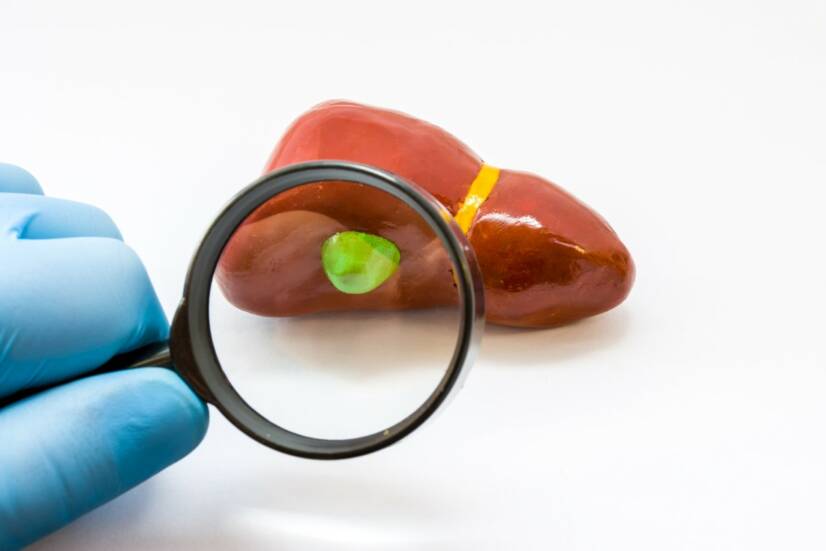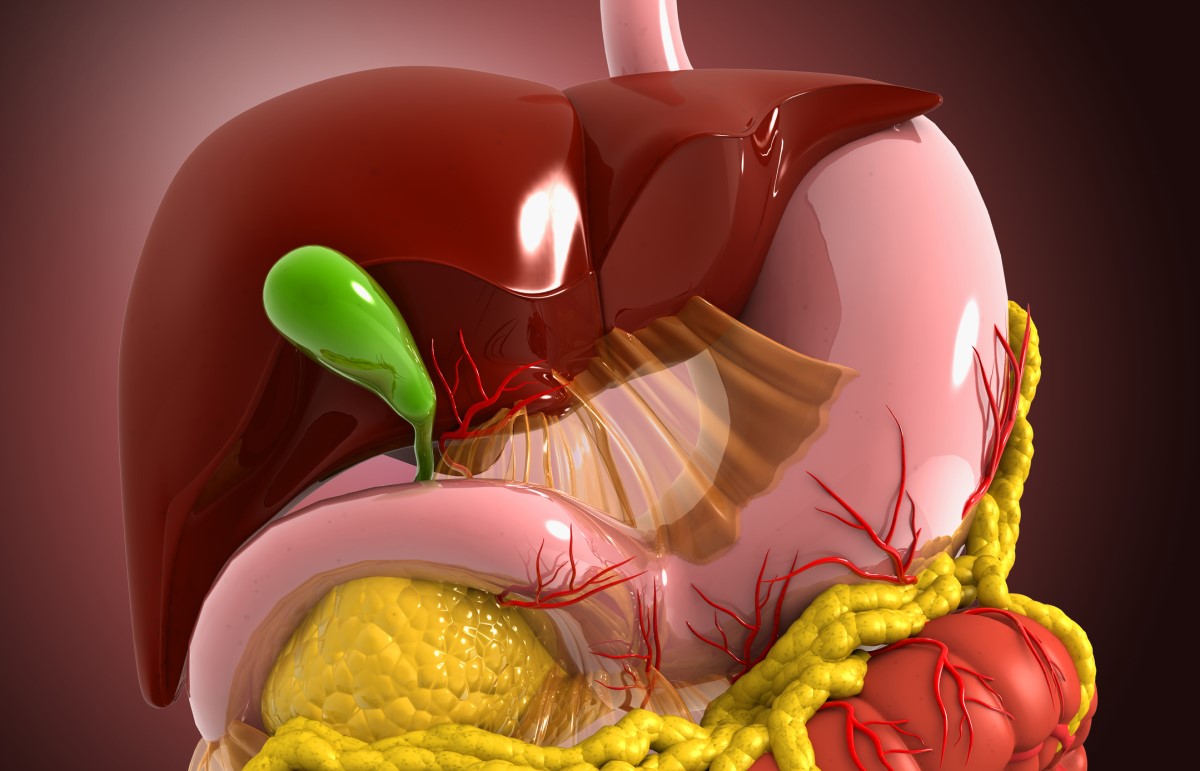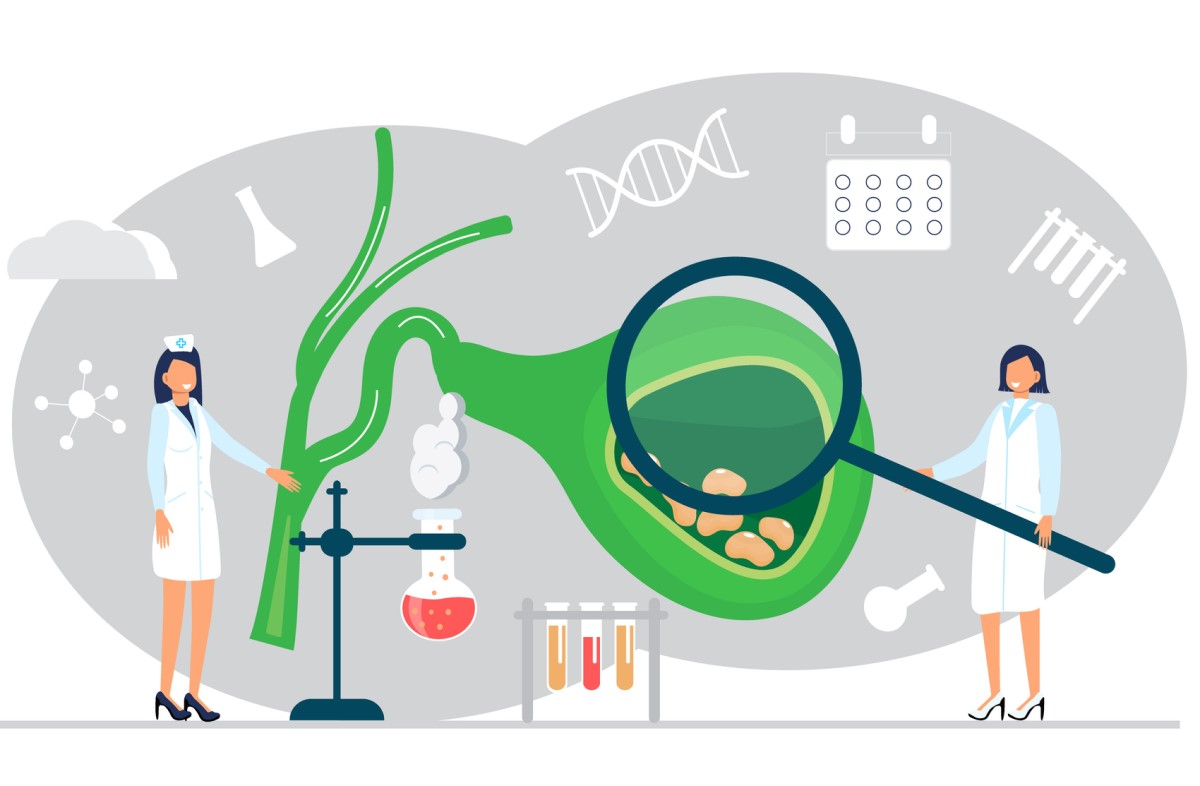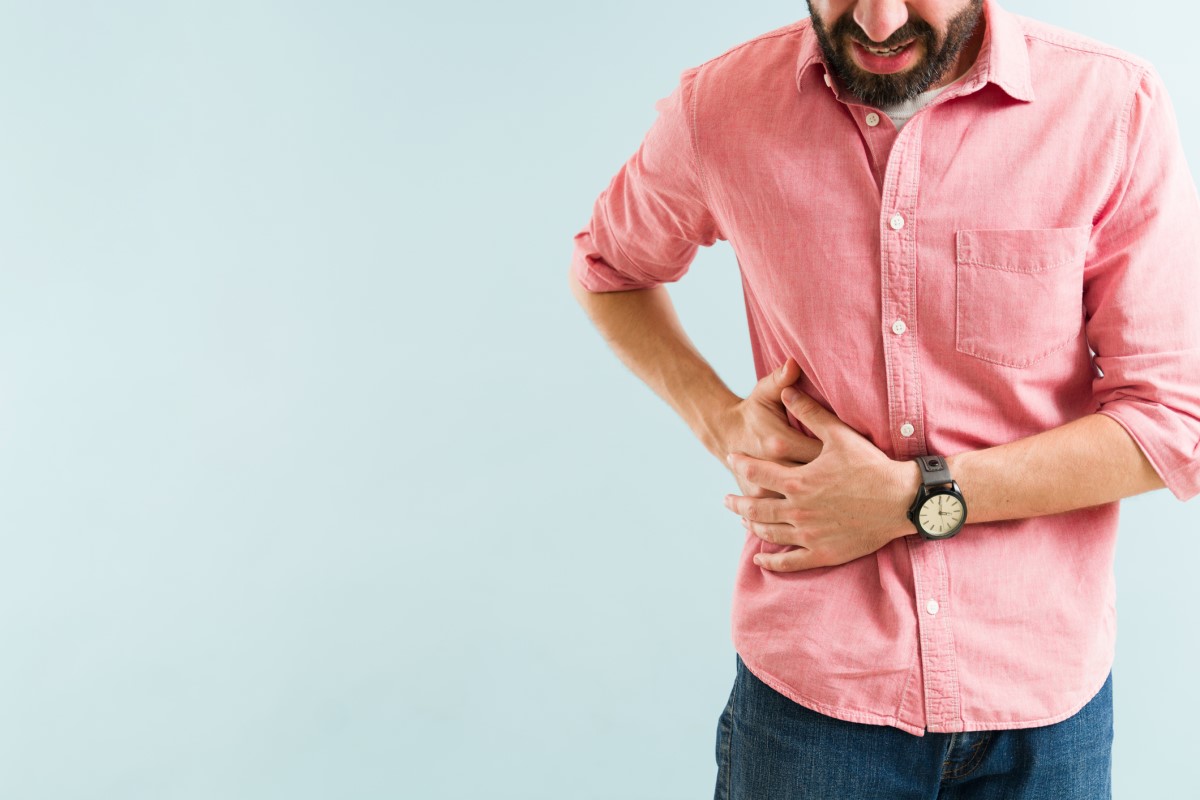- somfarmaceut.sk - Proper dispensation: formation and outflow of bile, PharmDr. Peter Stanko
- my.clevelandclinic.org - Gallbladder
- pubmed.ncbi.nlm.nih.gov - Functions of the Gallbladder
- webmd.com - Gallbladder Diet
- ncbi.nlm.nih.gov - Physiology, Gallbladder
Bile and gallbladder: what are their functions? The formation of bile and how to maintain health?

The gallbladder is a small hollow organ that you can think of as a pear-shaped sac.
Article content
- What important functions does bile have in our body?
- Where is bile formed?
- Bile has to have precise timing... Who controls it?
- When the perfect machine gets stuck.
- From gallstones to gallbladder inflammation
- Cholecystitis and cholangitis
- Watch out for certain medications, they may be causing your gallstones
- What to choose in the pharmacy when you hear gallbladder colic?
- The gallbladder can also be soothed by an appropriate diet
Some people mistakenly believe that bile is formed in the gallbladder. However, this is not true. Bile is only stored and thickened in the gallbladder. For more important functions and importance of the gallbladder and bile, see this article.
The gallbladder, along with the bile ducts and the ducts of the gallbladder and pancreas, form the so-called bile ducts, which are also called the biliary tree.
The biliary tree is a tangle of ducts located in the liver, leading from the gallbladder and pancreas, which empty into the small intestine in an area called the duodenum.
The bile ducts are divided according to their location into intrahepatic (inside the liver) and extrahepatic (outside the liver).
The gallbladder is located under the liver, in the right upper quadrant of the abdomen, attached to the lower surface of the liver in the gallbladder fossa. It is part of the extrahepatic biliary system.

What important functions does bile have in our body?
Its main role is to aid in the digestion and absorption of fats. In order for fats from ingested food to be absorbed and used, they must be emulsified. This increases their solubility and makes them more accessible to lipases - the enzymes that digest fats.
Bile is a yellow-brown to yellow-green fluid that forms in the liver. Up to 82% of bile is water and electrolytes. It has alkaline properties, a higher pH, making it slightly basic. The central component of bile is mineral salts (12%), which are key in the emulsification of fats.
Bile has another important function. It can neutralise the contents that come from the stomach. Here, food is digested in a strongly acidic environment with the help of hydrochloric acid.
This digestion passes into the small intestine, whose mucosa is more sensitive to the acidic environment than the resistant mucosa of the stomach.
Where is bile formed?
Our body produces 500 to 750 millilitres of bile in a day.
It is one of the few bodily fluids that are formed daily. So don't underestimate your daily drinking regime. The water you take in is converted into valuable fluids by your body.
Bile is formed in the cells of the liver, called hepatocytes. Between each cell are thin bile ducts that form a tangle of bile ducts throughout the liver.
These bile ducts secrete substances such as lecithin, conjugated bile salts, hormones, cholesterol and bilirubin. Cholesterol secreted into the bile removes most of the cholesterol in the body.
From these substances, the resulting bile is formed by complex chemical processes. It is carried to the gallbladder where it thickens and awaits its opportunity to be expelled into the small intestine.
The most valuable component of bile is bile acids, so the body recycles them. In the intestines, they are reabsorbed and absorbed into the portal vein, which carries blood from the intestine to the liver.
In the hepatocytes, bile acids are reused to produce bile. Only 5% of bile acids are excreted in the faeces.
Bile has to have precise timing... Who controls it?
We already know that bile is formed in the liver, where it is then stored and concentrated in the gallbladder.
As food passes from the stomach into the small intestine, bile is released from the gallbladder to aid in the digestion of insoluble fats. It is this stimulation of the small intestine by fatty foods and proteins that causes the gallbladder to empty bile into the duodenum.
In the lining of the small intestine and jejunum are special enteroendocrine cells called I-cells. When these cells detect the presence of fatty acids and amino acids, they release a peptide hormone called cholecystokinin (CCK).
Cholecystokinin has two important roles in proper gallbladder function. The first role is to control the muscles of the gallbladder. Their contraction and relaxation control the timing of bile secretion.
The second role of cholecystokinin involves the so-called sphincter of Oddi muscle.
When the bile leaves the gallbladder, it flows freely into the common bile ducts. It reaches the confluence with another duct leading from the pancreas. This main pancreatic duct is called the papilla of Vater.
The bile then enters the duodenum through an opening called the main duodenal papilla. The flow of bile through the papilla is controlled by the opening and closing of the sphincter of Oddi, which is stimulated by cholecystokinin.
When we do not take in food, i.e. when we are fasting, cholecystokinin is not released. At this time the gallbladder is relaxed and can fill with bile.
In addition to the gallbladder, cholecystokinin is also important for stimulating pancreatic secretion. It also delays further emptying of the stomach, giving the body time to digest properly.
The release of cholecystokinin is inhibited by the hormone somatostatin.
When the perfect machine gets stuck.
Even when gallbladder function is perfectly controlled, there are situations that lead to problems and painful conditions. The most common difficulties associated with improper gallbladder function include gallstone formation.
An imbalance in the components that make up bile, bile sludge and irregularity in the emptying of the gallbladder leads to the precipitation of insoluble stones.
The insoluble gallstone blocks the natural outflow of bile and causes pain, inflammation and subsequent infection. Without treatment, this condition leads to irreversible damage to the gallbladder and many other organs.
Impaired bile production and secretion, or cholestasis, is a condition in which the outflow of bile into the small intestine is blocked.
There are two types of cholestasis.
Intrahepatic cholestasis is caused by a malfunction or damage at the level of the ducts in the liver.
Extrahepatic cholestasis is caused by blockage of bile ducts outside the liver.
Intrahepatic type of cholestasis is encountered in some congenital diseases, liver cirrhosis, infectious diseases(HIV, HBV, CMV, EBV), when taking certain drugs (antibiotics, steroids, contraceptives, antipsychotics) or during pregnancy.
The extrahepatic form is caused by obstruction of the bile ducts, e.g. gallstones, tumour, cyst, etc.

From gallstones to gallbladder inflammation
Gallstones in the gallbladder are technically called cholelithiasis. They are caused by an imbalance in the ratio of bile components and in situations of biliary stasis - when bile does not drain from the gallbladder and is stored in it for too long.
The most common are cholesterol or pigment stones.
Up to 80% of the stones in the gallbladder are cholesterol stones.
They are associated with certain risk factors such as female gender, obesity, age around 40, female sex hormones such as estrogen, or pregnancy.
Sudden and too rapid weight loss is also a risk factor. The liver then releases more cholesterol into the bile, leading to the formation of cholesterol stones.
Pigmented stones are divided into brown and black.
Black stones are formed from calcium bilirubinate. Because they contain a high proportion of calcium, like bone, they are visible on X-rays.
They form secondary to other diseases that cause haemolysis, or the breakdown of red blood cells. As the red blood cells break down, large amounts of a red dye called haem are secreted. This dye is further metabolised into bilirubin.
The increased amount of heme leads to a high concentration of bilirubin in the bile and the formation of black stones.
Brown stones are formed after an infection.
Gallstones are usually asymptomatic. But if a stone gets into the bile duct, it causes a condition called biliary colic.
Gallbladder or biliary colic is accompanied by severe pain under the right rib arch. The pain usually occurs about half an hour after eating a fatty or greasy food and a sweet one at the same time.
The fats contained in this food stimulate the secretion of cholecystokinin, which causes the ducts to contract and the stone to get stuck.
Choledocholithiasis is the name given to a lodged stone present in the common bile duct - the choledoch.
Blockage of the bile duct by a stone causes changes in laboratory values such as liver enzymes like ALP, GMT, AST, ALT and bilirubin, which increase rapidly.
If the stone has travelled a little further, it has reached the pancreas. The amount of amylase and lipase in the blood rises, indicating a condition complicated by a dangerous inflammation of the pancreas - pancreatitis.
Cholecystitis and cholangitis
Cholecystitis is the name given to inflammation of the gallbladder, which is most often caused by gallstones in the cystic duct. This type of inflammation is then called calculous cholecystitis.
Unlike gallbladder colic, where the pain is severe, acute and short-lived, cholecystitis is manifested by prolonged abdominal pain with associated fever and leukocytosis.
The most serious complication of untreated acute cholecystitis is infection with overgrown bacteria.
Another complication is the development of so-called chronic cholecystitis, which occurs after repeated attacks of acute cholecystitis when the primary cause of inflammation (i.e. gallstones) is not addressed.
Persistent inflammation creates scarring and calcifications on the gallbladder wall that increase the risk of cancer.
Cholangitis is an inflammation affecting the bile ducts. The ascending portion of the bile ducts is most commonly affected. It is a secondary infection by overgrown bacteria during bile stasis.
The symptoms accompanying cholangitis are called the Charcot triad. This triad includes jaundice (caused by increased bilirubin levels), fever and pain under the right ribs.
To this triad of symptoms may also be added symptoms of shock and psychological changes. This is then a set of symptoms called the Reynolds pentad.

Watch out for certain medications, they may be causing your gallstones
There are many medications that can increase the risk of gallstone formation.
- Hormone replacement therapy, such as birth control or estrogen-containing drugs, causes an increase in cholesterol in the blood.
- Drugs similar to the hormone somatostatin, such as octreotide, block the release of cholecystokinin.
- Fibrates are drugs taken by patients with high cholesterol levels. The effect of fibrates is based on reducing bile acid synthesis. A side effect is to facilitate cholesterol clotting, which increases the risk of gallstones.
- Patients on total parenteral nutrition do not take in food via the gastrointestinal tract. Therefore, they do not stimulate cholecystokinin and do not have regular gallbladder emptying, which leads to bile stasis.
What to choose in the pharmacy when you hear gallbladder colic?
When you are regularly troubled by gallbladder colic, keep some of the medications on hand at home that can relieve the pain in the acute period.
These are drugs that stimulate the production of bile in the liver, also promote the secretion of bile into the small intestine, relieve painful spasms of the smooth muscles of the gallbladder, bile ducts and their muscular sphincters.
In addition to this effect, they are also hepatoprotective. They protect and regenerate liver cells that are damaged by bile stagnation.
Medicines containing hymecromone, fenipentol or herbal preparations containing natural essential oils are recommended.
Spasmolytics are used as symptomatic treatment. They relieve spasms and spasms of smooth muscles in the bile ducts and sphincters.
They are suitable for short-term use only, as an acute treatment rather than as a repeated, long-term or preventive treatment.
Drugs containing butylscopolamine and drotaverine have a proven effect.
The gallbladder can also be soothed by an appropriate diet
After an attack of gallbladder colic, it is important to let it breathe and soothe the irritated bile ducts.
A diet based on the following principles will help:
- Skip fatty, fried and deep-fried foods.
- Eggs, especially egg yolks, are also forbidden.
- A drop of olive oil is allowed in vegetable salads.
- Fresh sourdough bread is not suitable. You can substitute biscuits.
- Nuts, poppy seeds, various seeds, legumes and spices, fatty dairy products and cheese are not recommended.
- Halloween will have to do without chocolate and sweets.
- You will have to do without coffee for a few days, black tea is allowed.
- Include fiber-rich foods such as vegetables. For fruits, omit cabbage, kale, onions, garlic, green peppers, pickles, grapes, pears or cherries.
- Lean white meat prepared by boiling or stewing is allowed. Do not fry, do not grill!
- Vegetable broth is an appropriate soup choice. Chicken broth may also be prepared, but without the addition of oil or onions in oil.
- The important thing is to take your food in smaller portions and regularly. In this case, the old adage that breakfast is the most important meal of the day applies. Therefore, do not skip it.
- Adherence to the drinking regime is the alpha and omega of the gallbladder diet. Super fluid is of course plain water, tea or apple juice.
Interesting resources










